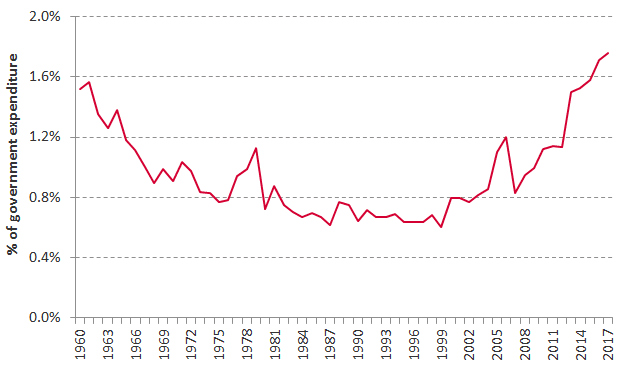What does the 2019 Spending Review mean for UK aid?
While the UK’s exit from the European Union continues to dominate the political and economic landscape, another important process looms: the 2019 Spending Review.
This will determine how government spending is to be distributed across departments beyond 2019–20, including spending on overseas aid.
What is the Spending Review?
The Spending Review is the process by which the government sets out its plans for public spending. The previous review was undertaken in 2015 and covered the four-year period up until (and including) the financial year 2019-20. Another Spending Review is now due in 2019. In the Spring Statement, the Chancellor stated that the results of this review would be announced alongside the autumn Budget, and that it would cover the three financial years 2020–21, 2021–22 and 2022–23.
The process focuses on the component of spending known as Departmental Expenditure Limits (DEL). This is what is allocated and spent by central government departments on the administration and delivery of public services, in contrast to “demand-led” expenditures such as benefit payments and spending by devolved administrations.1
Setting the path for DEL is a significant decision: this spending comprises approximately 40% of total government spending. For overseas aid, the decision over DEL is even more significant: virtually all of the spending by the Department for International Development (DFID) – 94% in 2017-18 – falls into this category. Spending can be further sub-classified as resource spending (day-to-day spending on, for example, wages of public sector employees) or capital spending.
Subscribe to our newsletter
Our weekly email newsletter, Network News, is an indispensable weekly digest of the latest updates on funding, jobs, resources, news and learning opportunities in the international development sector.
Get Network NewsProvisional plans for overall departmental expenditure imply that capital spending is set to grow over the next five years, while day-to-day spending will, after taking account of economy-wide inflation, increase by less than the additional funds that have already been committed to day-to-day spending on the NHS in England. Keeping to these totals would imply a tight Spending Review for many departments.2 But the Chancellor indicated that securing a good Brexit deal could enable him to spend more than implied by the provisional plans.
Aid and the public finances
Unlike most of its peers, the UK has met the UN’s target on aid by spending (almost exactly) 0.7% of Gross National Income (GNI) on Official Development Assistance (ODA) since 2013. This commitment was enshrined in law in 2015 with cross-party support, meaning aid spending has been protected over the current review period (reaching 1.7% of government expenditure in 2017). UK ODA in 2019 is expected to be 13% higher in real terms than in 2015, and 50% higher than in 2010. This contrasts sharply with “unprotected” areas of spending – outside of health, defence and overseas aid – that have faced reductions in day-to-day spending averaging over 20% since 2010. Some areas of spending have fared much worse: the Ministry of Justice and Department for Environment, Food and Rural Affairs have each seen a reduction in their DEL of around 40% since 2010-11.

Figure: UK aid as a percentage of total government spending
Despite continuing debate about the 0.7% target, it’s likely that the UK will continue to meet the target in the near future. Thus, the more pressing question for aid in this Spending Review is where this spending will be spread across government and how this process will be managed.
Allocating ODA across government
In recent years there has been a trend for more of UK aid to be spent by agencies other than DFID. In 2014, DFID accounted for 86% of UK ODA spending, by 2017 this had fallen below 73%. While DFID’s aid spending is much greater now than in 2012 – the last year in which the UK did not spend 0.7% of national income on aid – it has actually fallen slightly in real terms each year since 2013.
The official rationale behind this shift was formalised in the 2015 aid strategy which was published as part of the last Spending Review (although the trend predates this). The strategy emphasises a cross-government approach to aid that makes the UK’s national interest a more explicit consideration. In practice this means a broader distribution of ODA spending across government, plus some changes to thematic priorities – for instance, increased spending on research and in fragile and conflict-affected states.
In implementing this strategy during the 2015 Spending Review, HM Treasury invited all departments to determine which of their existing activities could be classified as ODA, and to submit bids for new ODA-eligible activities. In all, 12 Departments submitted 61 separate bids with a total value of £18 billion – enough to cover a third of the UK’s ODA spending over the period to March 2021. Recently published figures show that the final ODA allocation over the current Spending Review period – including ODA that was not available for bidding in the initial allocation process – allotted £42 billion to DFID and £12 billion for other agencies.
Concerns have been raised about how this process was managed. For instance, while the Treasury asked departments to specify the objectives and costs of each project, how it aligned with strategic objectives, and its eligibility for ODA, it did not ask them to provide information on their capacity and capability to implement ODA programmes, or their plans for monitoring and evaluating project outcomes.3
Furthermore, it is notable that standards of aid transparency differ substantially across government. DFID scores highly in the Aid Transparency Index from Publish What You Fund (PWYF), while the Foreign and Commonwealth Office – the only other UK department currently included – is one of the lowest ranked donors. The government has committed to having all departments evaluated according to this index methodology and ranked as either ‘Good’ or ‘Very Good’ by 2020 (with PWYF commissioned to undertake an assessment for 2019).4
Given these concerns, the 2019 Spending Review provides an opportunity to improve this allocation process, and place greater emphasis on ensuring that departments are well-equipped to deliver, monitor and report on ODA programmes effectively in order to support the objectives of UK aid.
Further nudges from HM Treasury
Beyond allocating the total amount available for each department, HM Treasury may impose other conditions and targets on UK aid in the Spending Review.
The composition of ODA spending may be adjusted, for instance. Over the current Spending Review period, DFID was set a target of £5 billion for “non-fiscal” spending, which creates a returnable financial asset and as a result does not add to the headline measure of the deficit.
The majority of this kind of spending by DFID since 2015 has been in the form of recapitalisations of CDC Plc, the UK government’s development finance institution. In 2017 DFID published a business case for investing up to £3.5 billion of capital in CDC over the period 2017-2022. Recent years have also seen much faster growth in other capital spending by DFID: between 2010-11 and 2019-20, DFID’s capital DEL (which excludes injections into CDC) is projected to increase by 70%, compared to 20% for resource DEL. Given provisional spending plans which suggest a more generous settlement overall for capital spending than for day-to-day spending, one might expect this pattern to continue for overseas aid too, which may imply further growth in DFID’s research funding and areas covered by the department’s Economic Development Strategy.
The Treasury may also make other requests of departments in the Spending Review. Over the current review period, DFID has been required to deliver £400 million in efficiency savings. The International Development Committee (IDC) report that the department is on track to exceed this target by £100 million by the end of the 2019/20 financial year, and in 2017/18 administration costs accounted for 0.9% of DFID’s total spending, down from 1.1% in 2014/15 and 2.3% in 2009/10.
All else being equal, low administration costs are desirable, but a 2017 IDC report expressed concerns that, partly as a result of efficiency targets, administrative capacity within DFID had “fallen below what is required to manage its increasing budget optimally”, with an increasing preference for working with larger external organisations who can internalise administration costs within programme costs.
Uncertainty beyond the Spending Review
While economic uncertainty and fiscal objectives mean that the Chancellor has some difficult decisions ahead in this year’s Spending Review, the legislated commitment to spend 0.7% of national income on aid – and the UK’s approach of meeting it exactly every year – provides some certainty about ODA in this process. However, with aid spending tied to national income and its purchasing power susceptible to currency changes, macroeconomic developments beyond the Spending Review (including the effects of the EU withdrawal process) may still have material consequences for the overall scope of UK aid.
Footnotes:
1. These are known as Annually Managed Expenditure (AME).
2. For more background, see the talk “Modest Windfall Banked (For Now)” by Carl Emmerson at https://www.ifs.org.uk/spring-statement-2019
3. Some departments, such as the Department for Environment, Food and Rural Affairs (DEFRA), provided this information, however.
4. On the basis of information published from July 2018 onwards.
Category
News & Views



